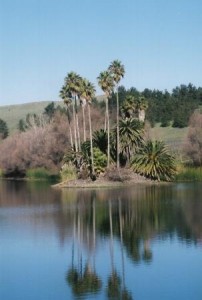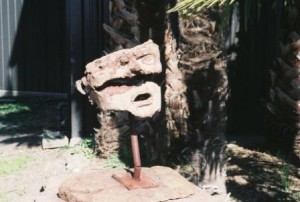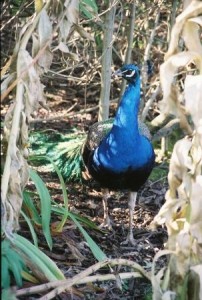 “Divinely regional, superbly parochial, wondrously provincial. . .an absolute native glory.”
“Divinely regional, superbly parochial, wondrously provincial. . .an absolute native glory.”
Rene di Rosa
Last week I took a vacation day in the middle of the week and gorged myself on art.
It was another unseasonal January day, blue sky from horizon to horizon, fruit trees already starting to bloom, sixty-five degrees as I drove toward Napa. I had an eleven o’clock reservation at the diRosa Art Preserve, on Highway 12 in the Carneros district, to take the one-hour tour.
If you are driving toward Napa on Highway 12, on your left you will see an earthen dam with cutout sheep grazing on it. Off to one side is an industrial-looking building sided in corrugated metal. That’s the gatehouse gallery, the first of three galleries in the diRosa Art and Nature Preserve.
I pulled in about fifteen minutes early. My car was the only one in the lot, and the only other people were two men pruning roses along the graveled ramp that led up to the gatehouse. They both smiled and said good morning. When I got to the top the first thing that greeted me (after the large ceramic Viola Frey sculpture of a woman) was the lake. On the eastern shore, an egret waited, one leg curled up in a classic egret pose.
The gatehouse looks even more industrial up close. The wall facing the lake is mostly glass. You are allowed t o take pictures outside, but not inside any of the galleries; I don’t know if the staff haven’t realized that the gatehouse leaves a large loophole in this policy or if they don’t care. Anyway, I pulled open the heavy but balanced door and stepped into a small charming space that is the reception desk and gift shop. The pleasant woman behind the counter told me I was welcome to browse the Gatehouse Gallery while I waited for my docent. The gatehouse gallery is open to the public, no tour needed, Wednesday through Friday.
o take pictures outside, but not inside any of the galleries; I don’t know if the staff haven’t realized that the gatehouse leaves a large loophole in this policy or if they don’t care. Anyway, I pulled open the heavy but balanced door and stepped into a small charming space that is the reception desk and gift shop. The pleasant woman behind the counter told me I was welcome to browse the Gatehouse Gallery while I waited for my docent. The gatehouse gallery is open to the public, no tour needed, Wednesday through Friday.
Rhinocar, one of David Best’s collage cars, confronted me as I went around the corner into the long open space. Every inch of the car’s body is covered with objects, and the torso of a rhinoceros emerges from the hood. The inside of the cab is also decorated. There is . . .something. . . in the passenger side, but I’m not sure quite what it was. Art cars or collage cars aren’t particularly uncommon—there are two in the town where I live—but this example is exceptional, as is “Mama Tina’s Car” by the same artist, in the main gallery.
The gatehouse silo holds an interactive display involving either steam or dry-ice vapor, and a long upright receptacle filled with sand, air and water that creates the effect of seawater on sand as the water bubbles up to nearly the top, then slowly drains, leaving designs that looks like cities or r iver tributaries along the glass.
iver tributaries along the glass.
There were also paintings, including my favorite in the exhibit, “The Great Battle of San Francisco.” Sixty-four by sixty-four inches, this oil and acrylic piece depicts a fictional battle for the city of San Francisco, with street armies mounted on horses or motorcycles battling, massed behind banners reading, “Ask Me about Free Checking,” or “Smog Test; You Don’t Pass, You Don’t Pay.” Behind the massed figures in the foreground lies the city, plumes of smoke rising from various areas, tiny fighter planes and helicopters dotting the sky. It is simultaneously realistic and fanciful, like the best science fiction. I kept drifting back to it, finding more bits of social comment each time I looked.
The second half of the gallery is devoted to rotating exhibits, usually by one artist, so I looked at “After the Age of Reason,” by Maria Porges. Her work is technically good but there was a sameness to the work and I disengaged pretty quickly. She had a couple of pieces using books that I did enjoy.
At eleven Ann, our docent, showed up. It had looked originally like the tour was going to be me, just me, but three more people dropped in so we made a group of four. Ann glanced pointedly at the camera on my hip while she politely reminded us that there could be no pictures taken inside. I equally politely didn’t rat out the man in the trio, who had taken at least three pictures of Rhinocar before she showed up. She took us quickly through the Gatehouse, and led us outside to the “jitney,” a truck with one of those long carts attached to it, like they have at Disneyland and the San Diego Wild Animal Park. She pointed out that one pleasant side effect of the dry winter was that the wild mustard was already beginning to bloom in the vineyard. I chose to sit facing the lake, so I could see the egrets, the cormorants sunning themselves on Veronica di Rosa’s blue metal cow that sits in the lake, and the two blue herons roosting in the willow trees along the water’s edge. Several more of Veronica’s cows lined the lake. Veronica also made the sheep on the dam.
The main gallery is more than twice the size of the gatehouse, I think. Before we went in, Ann gave us a little bit of background on di Rosa. He was born into money, son of the Italian consul general to the U.S. and a St Louis heiress. He went to Paris as a young man and lived on the left bank, planning to write the Great American Novel. Ann said, “And like so many others, he didn’t.” He became interested in art in Paris, and when he came back to the states and got a job with the San Francisco Chronicle, he began checking out the North Beach art scene.
Using money from an inheritance, diRosa bought 750 acres in the Carneros area in the early 1960’s. It hadn’t been used for grapes in about forty years, since phylloxera and Prohibition had wiped out the grape trade in the 1920’s. He knew grapes would grow there, though, so he took some viticulture and agriculture classes at UC Davis, and turned most of the acreage into vineyard. As a bonus, in Davis he encountered many new artists who ended up in his collection.
Clearly, di Rosa got ahead of the wine-making curve and made tons of money during the seventies and early eighties. He bought art this whole time. Rene di Rosa’s trick, he said, was to find new artists that he liked and buy their work while “he could afford it.” He and his second wife, Veronica, continued to collect. The current art collection exceeds 1700 pieces.
In the late eighties the diRosas sold about half their acreage to Seagrams, and used the money to build the main gallery and turn the property into an art and nature preserve. Many of the preserve’s strict rules come from the fact that it is nature and agricultural preserve land.
My friend L has two pieces in the diRosa collection. One was on display in the main gallery, but I couldn’t find it in the time we had. Di Rosa bought what he liked, so his collection, even though it is dubbed “San Francisco Art” or “Northern California Art” now, is eclectic. A better category name would be “Art Rene di Rosa Liked.” There are large figurative sculptural pieces, realistic paintings, abstract impressionistic paintings, conceptual pieces large and small, works using video, found objects, ceramics, cloth, bronze, and marble. There are photographs, there are collages. Many pieces are humorous, many are disturbing. One of the most disturbing and powerful pieces in the collection is a plaster sarcophagus, opened lengthwise, each half flanking a raku-fired mummified figure, shriveled and wizened. The piece is named after a friend of the artist, who died of AIDS in the eighties. The artist’s friend requested that the artist take a plaster full-body casting of him after he died, and make a piece “that demonstrated the devastation of this disease.” The artist did, and he completely succeeded. The piece is shocking and powerful, and I wondered how much more strongly the political import of its message must have played in the mid-eighties. Now it could represent starvation in Darfur, death in New Orleans in the wake of Katrina, or Hiroshima after the bombing. It has  become timeless
become timeless
Since we lollygagged in the main gallery, Ann had to hurry us a bit. She shared Chartres Bleu with us, a stunning video installation, and gave us a glimpse of the Sculpture meadow. Along the way we saw two of forty-something diRosa peafowl, both males, dragging their long tails through the greenery. She led us through the ground floor of the residence, the third gallery. Every space in every room is filled with art. There is a loft and a cellar that hold art as well—you get to see those on the longer tour, as well, I think Ann said, as a drive around the lake.
Ann also pointed out the “lynched Volkswagen.” The story goes that di Rosa wanted David Best, the collage-car guy, to make a collage car just for Rene, the way he had for Rene’s mother “Mama Tina.” Best wouldn’t, so di Rosa bought a car, stripped out all the innards, and winched it up so it hangs from an oak tree branch. Is it art? I don’t think so. It is funny? Yes.
There was more—there’s art everywhere you look—but this was only the one-hour tour. It was a few minutes past noon when I backed my car out of the parking space. I stopped in Boyes Springs to have lunch at the Breakaway Café in the Rite Aid center. The Breakaway is plain food, not exotic, and is always good. It’s a better breakfast place than a lunch place but lunch is good too. The staff are always friendly and cheerful. After a tuna melt with real, if mild, cheddar cheese, and a mocha, I was ready for Round Two; the Sonoma County Museum’s exhibit on robots.

I’ve driven by the preserve so many times. I love the sheep on the hills, especially the black one.
I didn’t realize there were art galleries there. I’ll have to make it a point to visit them.
I love your photos, especially the peafowl.
And I didn’t get out to the robot exhibit on Sunday. This coming weekend, for sure.
I especially like the black sheep. If you take the tour, you will also enjoy Veronica’s metal cutout cows, which are also whimsical and wonderful. I hope you enjoy the robots. I know I did.